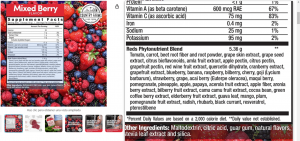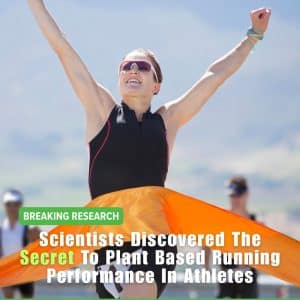As you may know if you’re already a follower, I started taking a greens supplement last year in an attempt to develop an overall healthier routine and dial in my nutrition.
I wrote a pretty in-depth piece on the benefits I experienced as well as some of the specific biomarkers I was able to track both before and after starting.
As such, I was interested in trying a Reds supplement to round out my nutrition profile since my experience with greens had been so positive.
The preliminary research I had done suggested Reds might not only be good for overall health, but actually be a bigger benefit to my running and recovery.
So, as I do with all the supplements I’m interested in, I started digging into the research.
In today’s article, we’re going to look at…
- What exactly reds are and how they differ from greens
- The most important ingredients you should look for and what you should avoid
- Plus some of the specific benefits you might expect.
Difference between reds and greens
The first thing we need to start with is understanding what Reds actually are and how they are different from greens.
Like greens, reds are dehydrated versions of dehydrated fruits and vegetables.
This dehydration process allows reds and greens supplements to better absorbed than something like a multivitamin because it’s in a more natural form.
This process also allows many of the natural phytonutrients, such as the anthocyanins found in berries, to be absorbed.
The main difference between reds and greens is that most greens supplements are going to contain mostly green vegetables and super foods, such as kale, spirulina, and wheat grass whereas reds are going to contain mostly fruits, such as beets, pomegranate, raspberries, acai, or blueberries.
In terms of purpose, generally speaking, a greens supplement is like an insurance policy against a less than perfect diet or just a more convenient way to make sure you’re getting your daily dose of vegetables.
Reds on the other hand are not only a way to increase intake of red-pigmented plants and the types of vitamins, minerals, and antioxidants found in them, but also a way to boost nitric oxide levels.
Nitric oxide doesn’t get as much coverage as other aspects of performance, but research has shown pretty impressive benefits to performance as well as overall health, especially as you get older or if you suffer from high blood pressure.
In addition to having complementary nutritional profiles, these two super food powders have synergistic health benefits.
So, why don’t companies just make a powder with both reds and greens included?
I’ll dig into this a little more when we get into what to look for in a reds supplement, but generally speaking companies don’t make supplements with reds and greens combined because of the cost and dosages.
Getting efficacious dosages into one package or one scoop would be unwieldy if a reds and greens supplement were combined.
The containers and scoops would be huge, logistics costs would increase, and studies have shown people are less likely to be consistent taking vitamins and supplements when dosage sizes are large.
So now that we know the difference between reds and greens and understand the unique benefits of each, let’s dive into what a good reds supplement should look like.
What Should You be Looking for in a Reds Supplement as a Runner?
Like I’ve talked about before when it comes to finding effective supplements, you’ll want to find a product that contains research-backed ingredients and one that has transparent and effective dosages.
Research-backed ingredients
The main thing you’re likely going to look for in a Reds supplement are ingredients that boost endurance, recovery and antioxidant levels, especially if you’re going to compliment it with a greens supplement.
This is because, as a runner, these are going to be the ingredients that are going to benefit you the most.
This is also where choosing a Reds supplement can be difficult.
What you’ll find is a lot of the cheaper reds supplements will often pack their supplement with trace amounts of many of ingredients to make the label look impressive. They assume you’ll look at the label and see the plethora of ingredients and assume it’s helpful.
The truth is that many of these ingredients have no scientific research supporting their effectiveness or are so low dosed that they offer no benefit.
It’s better to have 10-15 super helpful ingredients rather than 30 under-dosed or unsubstantiated ingredients.
I’ll get into what some of these are shortly.
A reds supplement with efficacious dosages
As with any supplement, the dosage of each ingredient matters and is one of the biggest differentiators between quality, effective supplements and those that don’t work and are a waste of money.
One way cheap supplement companies try to save money is by including effective ingredients, but not at the properly dosed levels.
You can have the kitchen sink of effective ingredients, but if they are not dosed properly than you’re not going to get any benefit.
A great example of this is beet root juice.
There’s a decent amount of research that beet root juice can improve running performance, but the studies indicate that the minimum effective dose is 500mg of nitrate (the actual effective ingredient) with the best results being shown around the 3-4 gram dosage level.
One way supplement companies try to hide this is with proprietary blends, which is the next big thing you should look out for.
No proprietary blends
You should almost always choose a product that lists the exact dosages of each ingredient and that doesn’t contain proprietary blends.
Proprietary blends are almost always used as a way to load the product with cheaper, less effective ingredients.
Let’s go back to our beet root juice example to illustrate.
We know from research that 3-4 grams is the minimum effective dose shown in research.
Here’s an example of the best-selling reds powder on Amazon that claims to provide the benefits of beet root.
As you can see, the third ingredient listed is beet root. However, we can see that the total proprietary blend is just 5.36 grams.
This means there is likely only a gram of actual beet root in this product.
From research, we know that smaller dosages don’t really provide any benefit, so having beet root in this particular supplement is basically useless.
The best ingredients for a reds supplement
Again, I am looking at the optimal ingredients in a reds supplement this through the lens of a runner and thus someone who is looking to maximize endurance and recovery.
Below are the ingredients, based on research the most important ingredients (or groups of ingredients), that I think should be included in a reds supplement for athletes/runners.
For criteria, I wanted to see multiple research studies showing a positive outcome (i.e. substantial evidence) with a high “magnitude of effect” (meaning the improvement or change was significant).
Because there are a lot of ingredients to sift through, I didn’t concern myself too much with those that only had one study supporting its impact or the results were mixed and showed limited effect.
Beetroot
Hands-down, one of the best ingredients for runners is going to be beetroot.
Beetroots got a lot of hype five or six years ago for being a “miracle” endurance booster, but like most supplements marketed as the next big thing, the hype didn’t quite match the scientific literature.
That said, research does indicate that beetroot does provide a benefit to endurance performance.
Studies show that beetroot can reduce fatigue during endurance events and improve performance by increasing nitric oxide levels and thus improving blood flow, which delivers oxygen and nutrients to working muscles.
Beet root has also been shown improve recovery and reduce soreness post-workout.
Perhaps the biggest advantage to having beet roots in a reds supplement is that taking a daily dose helps keep your nitrate levels high. The literature seems to suggest that consistently higher levels of nitrate are more effective than super dosing before running.
Cordyceps
Cordyceps is a mushroom known for its sports performance benefits.
It can help to support stamina and endurance and became popular in the 1990’s after a group of Chinese athletes attributed their Olympic success on the track to using a tonic containing cordyceps powder.
While this wasn’t the sole reason for their success (performance enhancing drugs were) this did kick off quite a bit of research on the endurance enhancing benefits of these mushrooms.
Take for instance, an Italian study involving seven amateur cyclists, which found that three months of consuming fungal supplements, including cordyceps, tamed exercise-induced oxidative stress, which the study authors speculate could help athletes better adapt to the rigors of strenuous training.
And one investigation in the Journal of Dietary Supplements showed that individuals who consumed a medicinal mushroom blend for a three-week period experienced improvements in fitness metrics such as VO2 max during a cycling test.
It’s believed that these endurance benefits are derived by cordyceps ability to improve cardiovascular function and thus deliver more fresh blood and oxygen to the muscles faster.
Cordyceps also contains adenosine which can support the production of ATP, our bodies energy currency.
In this way, cordyceps works in a similar way to creatine, helping your muscles store more of the molecules your body turns into energy. Research has found that this helps reduce fatigue and improve performance.
Tart Cherry
Tart cherry juice has gained much attention recently, among athletes and the general public, for its powerful anti-inflammatory properties.
Recent research has shown that tart cherry juice may be just as effective, if not more effective, than popular drugs that are most commonly used to treat inflammation.
Distance runners should be especially interested in tart cherry juice for its potential to reduce muscle soreness and shorten recovery time after long, hard endurance runs.
We actually wrote up a whole deep dive on the research regarding tart cherries for runners here. Please take a read if you want to examine the science in-depth.
Grapes, Blueberries, Raspberries and Strawberries
These berries are especially high in flavonoids called anthocyanins. Anthocyanins possess anti-diabetic, anticancer, anti-inflammatory, antimicrobial, and anti-obesity effects, as well as prevention of cardiovascular diseases
One clinical trial found that athletes in the 100-mg anthocyanin supplement group had a statistically significant increase in maximal oxygen consumption.
In another clinical trial, researchers who worked with runners who consumed anthocyanins or a placebo for five days before and two days after a marathon found that the anthocyanins group had reduced inflammation markers and showed a faster recovery in isometric strength.
One interesting tidbit I did come across in my research of anthocyanins is that they are expensive to produce. As such, you often won’t find them in lower priced greens supplements or you’ll find them buried at the end of a proprietary blend, suggesting it’s a micro dose.
Turmeric Extract
Turmeric contains over one hundred unique chemical properties that contribute to its countless therapeutic and anti-inflammatory effects.
Research suggests that Turmeric’s active ingredient Curcumin is responsible for the myriad of health benefits associated with Turmeric.
Curcumin is a polyphenol and targets multiple signaling molecules at the cellular level.
Curcumin has proven to have powerful antioxidant and anti-inflammatory benefits, which can help in the management of exercise-induced inflammation and muscle soreness, thus enhancing recovery, and optimizing performance.
In fact, a study from 2017 showed that athletes who supplemented with curcumin experienced less muscle damage during exercise and felt less soreness after exercise.
Pomegranate
If you remember my post from a few weeks ago, at the start of the year I started getting a lot of joint pain in my knees, especially when waking up.
Pomegranates contain CLA and antioxidants shown to block specific enzymes that are known to cause damage in those with osteoarthritis to improve joint health and mobility soreness.
There are also some studies that show pomegranates can delay muscle fatigue and increase blood flow, which can also help with recovery.
Anything else?
By no means is this an exhaustive list.
However, I went through 5 of the most popular reds supplements to research each ingredient to examine if they had supporting studies with a significant effect. These were the ones I found the most research on.
As I mentioned previously, throwing in more ingredients doesn’t always mean it’s a better product. In fact, in most cases more ingredients signifies it’s less effective.
This is usually because the ingredients without scientific support are usually cheaper and this results in the effective ingredients being under dosed.
As such, I find the reds supplements with 10-15 total ingredients to be the most effective, especially for runners and athletes.
Benefits or how I’ve felt
I’ve been taking a reds supplement for the last 3 months and I definitely feel like they’ve made an overall difference in how I feel.
Subjectively, I’ve noticed a lot less aches and pains when waking up in the morning, which may be due to the antioxidants and enzymes in reds that help with joint mobility and soreness.
The last month or so, I also seem to be recovering from my runs a little faster, which I’ve mainly felt during my strength work in the gym post run. I’ve felt more fresh during these sessions and have been able to progressively increase reps and load more than I had this time last year.
Finally, and maybe most importantly for me, I’ve been able to stay healthy during a time when almost everyone else in the family has gotten sick.
I have no way of knowing how to attribute this, but living with 4 kids definitely increases my exposure to germs, which is one of the big reasons I was so adamant about trying a reds supplement.
That said, the benefits I’ve perceived are all subjective. Therefore, like I did after I started taking a greens supplement, I am going to analyze some of my blood biomarkers to see what tangible difference they’ve made.
Before I started, I did some baseline tests so I could establish some before values. Now that I’ve been consistently taking the reds supplement and really enjoy it subjectively, I’ll test some of the biomarkers again to see if there were any changes.
I wanted to wait since some of these tests are pretty expensive and I didn’t want to jump into them before I knew I actually liked using a reds supplement and would keep it up.
Recommendation and how I take them
As I mentioned, I researched about 4 or 5 of the more popular and recommended reds supplements on the market.
I eventually chose Red Tonik because they were the only brand I found to really highlight the endurance boosting ingredients in sufficient dosages and also didn’t have any proprietary blends.
I was particularly impressed with the dosage of beet root, tart cherry, and berries. These were the ingredients a lot of reds brands I tried skimped out on, but in my opinion were some of the more important.
I have added Red Tonik to my morning routine along with my greens supplement.
They do have a fairly strong beets taste, which isn’t all together unexpected given the 4g of beet root. The greens and reds together seem to make it a little sweeter as well.
Taking my reds and greens in the morning has really helped me stick to a healthier routine overall. There’s something about starting the day on the right foot that makes it easier to make healthier choices throughout the day.
Overall, I feel like I really have benefited from taking a reds supplement, but I know it might not be for everyone.
I know it’s another cost, and I totally get that. In my case, I spend most of my discretionary income on items for running, performance and overall health. That’s not a good or a bad thing, just a reflection on why I feel the reds are worth it for me.
If you’re feeling like I was in regards to your health and looking for that path towards feeling more energized and healthier overall, I definitely recommend you give it a try for 30 or 60 days and see how you feel.
It’s one simple thing that can really get the ball rolling.
I hope you enjoyed this in-depth breakdown and stay tuned for the follow-up when I test some of my biomarkers, including nitrate levels and blood pressure.





